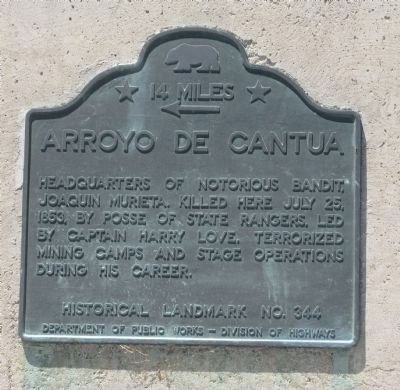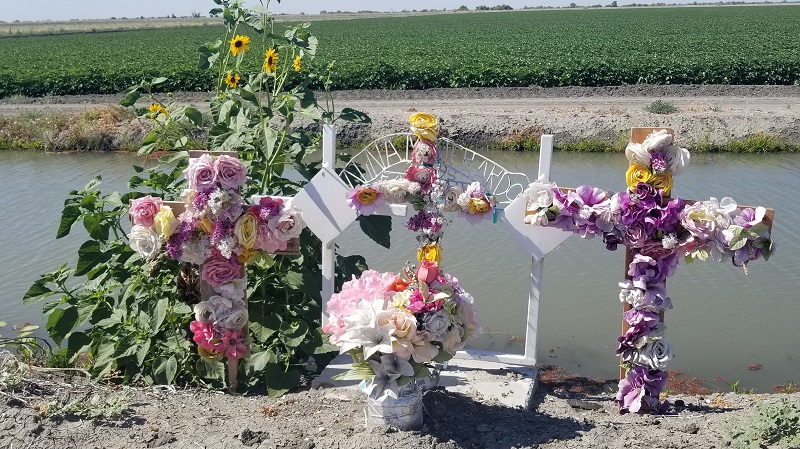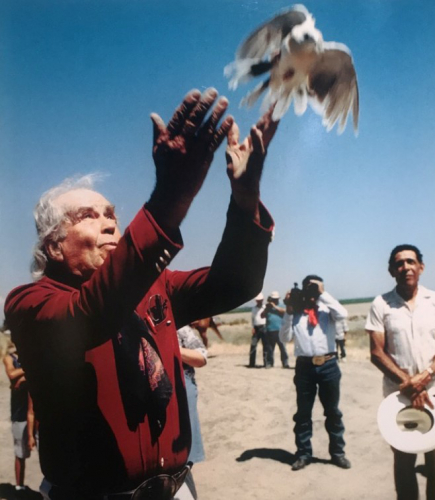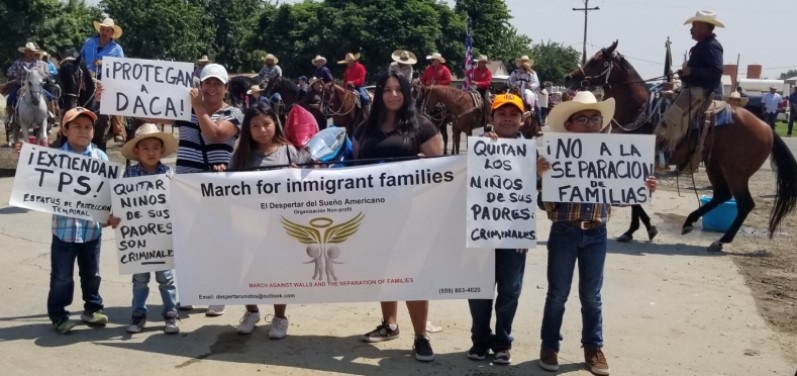From the Open-Publishing Calendar
From the Open-Publishing Newswire
Indybay Feature
Joaquin Murrieta and the Road to Three Rocks
In 1980 farm workers fight for their homes and dignity near Arroyo de Cantua, where the Murrieta band and California Rangers had their last, violent clash in 1853. For forty years, horse riders memorialize both events in Valley history.

First Intersection: “Five Joaquins” and Arroyo de Cantua
Pre-statehood Alta California was home to immigrants from Europe and Latin America, although most of the population spoke indigenous languages and Spanish. In 1848, gold was discovered in the confluence of the Sacramento and San Joaquin Rivers. Shortly after, a young married couple, not yet in their twenties, arrived in California. They were Joaquin and Carmelita Felíz de Murrieta.
White settler colonizers soon concluded that California had to become a part of the United States, although it was unclear whether it would be a slave or free state. They also had to rid the land of the Miwoks, who for three thousand years, had occupied the Sierra landscape surrounding the richest veins of ore.
Next, they turned to the “Mexicans” and other Spanish speakers, but that would require the creation of a myth. They needed a ruthless bandit who could simultaneously appear in distinct and distant locations, steal horses and valuables and allegedly kill a few defenseless settlers.
Whether he was in fact motivated by the lynching of his brother (Jesus Murrieta in Angel’s Camp, Stockton, California) and rape of his wife; Joaquin Murrieta would become the classic “bandido”. His descendants would claim that he only sought to bring justice to those who brought suffering to his family.
It was under the banner of law and order that marauding vigilantes and newly deputized “California Rangers” attacked Spanish speaking miners, seizing their digs, and sometimes their heads: hence, the “Five Joaquins”. That led them to the Arroyo de Cantua or what is now the Fresno Slough near Three Rocks. There, on July 25, 1853, the Rangers killed a man they called Joaquin Valenzuela and a few companions (including the Famous Three-Fingered Jack) and collected some body parts in order to claim the bounty.
Some historians suggest that “Tres Piedras” represents the three men who lost their lives there. Nobody knows with certainty whether Joaquin Murrieta was one of them, or he and Carmelita returned to Sonora, Mexico to live out their lives.
Second Intersection: the 1970’s, and the women of Three Rocks
In 1929, the Great Depression was followed by the “Decade of Betrayal” and the Mexican Repatriation campaign. A million Mexicans were rounded up and deported, even though sixty percent of them were U.S. citizens. Then came World War II and the “Braceros” came, or in some cases, returned from Mexico to save the crops and industries of the United States. Meanwhile, U.S. Armed Forces campaign records would show companies with men who fought on D-Day or in the Battle of the Bulge and claimed hometowns like Hermosillo and Mexico City.
The “immigrants” not only settled in west Fresno County, but were determined to live with dignity in the labor camps and rough tracts of land in Three Rocks, Cantua, San Joaquin and Huron. Although they had little education and worked in the fields, they believed that they deserved housing with basic services and living standards.
According to the Fresno Bee, in the mid-1970’s, Huron almost doubled in size, reaching a population of 2,340 while housing capacity hardly increased. This led to seasonal farm workers “spreading their blankets” and sleeping in the city park.
During the same period, Tres Piedras grew to 42 ramshackle houses and trailers with no gas, electricity, sewage or drinking water. It was home to farm working families who chose to live close the fields where they toiled. The women washed clothes outside, just like in the old country.
In 1979, Fresno County decided that the housing was not up to code, and the land lacked basic utilities: the people who lived there would have to go. The stage was set for a dramatic chapter in the history of the San Joaquin Valley. The main actors would be farmworker families led by strong women, and the Fresno County Sheriffs. The racist media declared them squatters and illegal immigrants, regardless of their status. Yet they chose to resist the Fresno County Board of Supervisors, PG&E and State authorities. The demolition of the homes was scheduled to begin on April 30, 1980.
The Third Intersection: the 1980’s and the spirit of Murrieta returns
Then came Sigurdur Christopherson, who would also come to be known as “Mexican Sigui”. Sigui was born in Canada, immigrated with his parents to San Francisco in 1936, and fought in World War II. He was a student of history and learned of the site in Arroyo de Cantua, where the last violent clash occurred between Joaquin Murrieta’s band and the 20 California Rangers under Captain Harry Love.
Upon learning of the plight of the families, he saw the parallels in history and injustice separated only by time. He wrote articles, mobilized supporters and channeled the spirit of Joaquin Murrieta. For several months, Sigui provided electric generators for the encampment and solicited support for the families.
According to Dr Melissa Moreno, there were many allies who played important roles as described by one of the women: “I remember this lawyer, Passion Millrow, was American but spoke Spanish. I remember she gave us motivation. Then she graduated from law school and we didn’t see her. But she helped us a lot. She gave us motivation.” The families also gained the support of Cesar Chavez and organizers from the United Farm Workers office in Huron.
Sigui met Julian Orozco Navarro, a man who travelled to the San Joaquin Valley from Mexico to work as a Bracero or “Guest Worker” in the 1950’s and 60’s. Don Julian eventually settled here and pursued his favorite pastime: riding horses.
According to Don Julian’s daughter, Juanita Orozco Gonzalez, “My father was very interested in this situation because he himself was a migrant farmworker. He felt it was his duty and honor to be part of such an important event.” They would soon win the support of Charros Unidos and their President, Jesse Lopez.
Prior to the day in April of 1980 when the demolition of the site was to begin, Sigui revealed his spirituality and had Native Americans bless the Arroyo de Cantua and the surrounding area. He sprinkled ashes on doves and set them free to encourage the spirits of the deceased men to go peacefully on their way.
On the morning of April 30th, the bulldozers appeared to begin the demolition and found 150 men, women and children remained there with their belongings. Those who abandoned their homes lost what was left of them to the machines. But the homes of those who stayed were not torn down: the families won the opening round. Soon, the Fresno Economic Opportunities Commission, the National Guard and Donaghy Sales Inc, a major Coors beer distributor, responded to the pleas for support. The Fresno Bee and other newspapers were won over and began to provide sympathetic coverage.
In July, the First Annual Joaquin Murrieta Ride was held, including the Charros Unidos horsemen of Madera. In September, the Fresno Bee announced, “Three Rocks Evacuation Stayed”, it would appear the community won a reprieve. In May of 1981 attorney Fernando Chavez filed a lawsuit for the People of Tres Piedras against the County of Fresno. The Joaquin Murrieta Ride was held again in 1981 and would continue each year, drawing as many as 300 riders.
History is seldom a straight road
History is seldom a straight road traveled from uncertainty to the realization of peoples’ dreams. For over 150 poor men, women and children of Tres Piedras it would be one of intersections and detours. Years would pass, and those dreams would only be realized for a portion of the original residents of Three Rocks. Many of them were resettled on 20 acres of land in Cantua Creek, just three miles down the road. Others went to another development known as El Porvenir or surrounding towns; others ended up in the city of Fresno. Two of the women contracted a crippling disease known as Valley Fever.
All they really wanted was to live their lives with dignity, and raise their children close to the fields where they toiled. “They all had their work weeding, irrigating, planting, and picking cotton, tomatoes, cucumbers, watermelons, cantaloupes…” Years later, the families of Cantua Creek would organize and fight for bilingual education. Cantua, El Porvenir and Raisin City would continue to protest against monthly utility bills approaching $200.
Some of the children who graduated from Cantua Elementary and the Golden Plains School District would go on to receive degrees and, in some cases, Doctorates, as was the case for Professor Melissa Moreno. Her thesis was the source of a number of the quotes, facts and chronology of events contained here.
So, we salute those brave men and women who fought for a better life in the fields and communities of Three Rocks, El Porvenir and Cantua Creek. Here’s to Julia, Dolores, Tony, Rosemary, Revas, Mage, Bob, Victor, Marion, Consuelo, Petra, the United Farm Workers, Cesar Chavez and his son, Fernando. “Passion Millrow”, actually Patience Milrod, would become a well-known attorney and advocate for the poor in the Fresno area.
Government and agency support came from the National Farm Workers Service Center, Sequoia Community Health Foundation, Fresno County Board of Supervisors (Board Chairman Juan Arambula), the City of Fresno and its Redevelopment Agency, Fresno Housing Authorities, Rural Community Assistance Corporation, California Rural Legal Assistance, and others.
And of course, there was Sigurdur ‘Mexican Sigui’ Christopherson, Don Julian Orozco Navarro, Jesse López of Charros Unidos and those who continue the Annual Joaquin Murrieta Ride. Finally, there are the spirits of three dead Mexicans, and Joaquin and Carmelita Felíz de Murrieta, wherever they may rest in peace.
Pre-statehood Alta California was home to immigrants from Europe and Latin America, although most of the population spoke indigenous languages and Spanish. In 1848, gold was discovered in the confluence of the Sacramento and San Joaquin Rivers. Shortly after, a young married couple, not yet in their twenties, arrived in California. They were Joaquin and Carmelita Felíz de Murrieta.
White settler colonizers soon concluded that California had to become a part of the United States, although it was unclear whether it would be a slave or free state. They also had to rid the land of the Miwoks, who for three thousand years, had occupied the Sierra landscape surrounding the richest veins of ore.
Next, they turned to the “Mexicans” and other Spanish speakers, but that would require the creation of a myth. They needed a ruthless bandit who could simultaneously appear in distinct and distant locations, steal horses and valuables and allegedly kill a few defenseless settlers.
Whether he was in fact motivated by the lynching of his brother (Jesus Murrieta in Angel’s Camp, Stockton, California) and rape of his wife; Joaquin Murrieta would become the classic “bandido”. His descendants would claim that he only sought to bring justice to those who brought suffering to his family.
It was under the banner of law and order that marauding vigilantes and newly deputized “California Rangers” attacked Spanish speaking miners, seizing their digs, and sometimes their heads: hence, the “Five Joaquins”. That led them to the Arroyo de Cantua or what is now the Fresno Slough near Three Rocks. There, on July 25, 1853, the Rangers killed a man they called Joaquin Valenzuela and a few companions (including the Famous Three-Fingered Jack) and collected some body parts in order to claim the bounty.
Some historians suggest that “Tres Piedras” represents the three men who lost their lives there. Nobody knows with certainty whether Joaquin Murrieta was one of them, or he and Carmelita returned to Sonora, Mexico to live out their lives.
Second Intersection: the 1970’s, and the women of Three Rocks
In 1929, the Great Depression was followed by the “Decade of Betrayal” and the Mexican Repatriation campaign. A million Mexicans were rounded up and deported, even though sixty percent of them were U.S. citizens. Then came World War II and the “Braceros” came, or in some cases, returned from Mexico to save the crops and industries of the United States. Meanwhile, U.S. Armed Forces campaign records would show companies with men who fought on D-Day or in the Battle of the Bulge and claimed hometowns like Hermosillo and Mexico City.
The “immigrants” not only settled in west Fresno County, but were determined to live with dignity in the labor camps and rough tracts of land in Three Rocks, Cantua, San Joaquin and Huron. Although they had little education and worked in the fields, they believed that they deserved housing with basic services and living standards.
According to the Fresno Bee, in the mid-1970’s, Huron almost doubled in size, reaching a population of 2,340 while housing capacity hardly increased. This led to seasonal farm workers “spreading their blankets” and sleeping in the city park.
During the same period, Tres Piedras grew to 42 ramshackle houses and trailers with no gas, electricity, sewage or drinking water. It was home to farm working families who chose to live close the fields where they toiled. The women washed clothes outside, just like in the old country.
In 1979, Fresno County decided that the housing was not up to code, and the land lacked basic utilities: the people who lived there would have to go. The stage was set for a dramatic chapter in the history of the San Joaquin Valley. The main actors would be farmworker families led by strong women, and the Fresno County Sheriffs. The racist media declared them squatters and illegal immigrants, regardless of their status. Yet they chose to resist the Fresno County Board of Supervisors, PG&E and State authorities. The demolition of the homes was scheduled to begin on April 30, 1980.
The Third Intersection: the 1980’s and the spirit of Murrieta returns
Then came Sigurdur Christopherson, who would also come to be known as “Mexican Sigui”. Sigui was born in Canada, immigrated with his parents to San Francisco in 1936, and fought in World War II. He was a student of history and learned of the site in Arroyo de Cantua, where the last violent clash occurred between Joaquin Murrieta’s band and the 20 California Rangers under Captain Harry Love.
Upon learning of the plight of the families, he saw the parallels in history and injustice separated only by time. He wrote articles, mobilized supporters and channeled the spirit of Joaquin Murrieta. For several months, Sigui provided electric generators for the encampment and solicited support for the families.
According to Dr Melissa Moreno, there were many allies who played important roles as described by one of the women: “I remember this lawyer, Passion Millrow, was American but spoke Spanish. I remember she gave us motivation. Then she graduated from law school and we didn’t see her. But she helped us a lot. She gave us motivation.” The families also gained the support of Cesar Chavez and organizers from the United Farm Workers office in Huron.
Sigui met Julian Orozco Navarro, a man who travelled to the San Joaquin Valley from Mexico to work as a Bracero or “Guest Worker” in the 1950’s and 60’s. Don Julian eventually settled here and pursued his favorite pastime: riding horses.
According to Don Julian’s daughter, Juanita Orozco Gonzalez, “My father was very interested in this situation because he himself was a migrant farmworker. He felt it was his duty and honor to be part of such an important event.” They would soon win the support of Charros Unidos and their President, Jesse Lopez.
Prior to the day in April of 1980 when the demolition of the site was to begin, Sigui revealed his spirituality and had Native Americans bless the Arroyo de Cantua and the surrounding area. He sprinkled ashes on doves and set them free to encourage the spirits of the deceased men to go peacefully on their way.
On the morning of April 30th, the bulldozers appeared to begin the demolition and found 150 men, women and children remained there with their belongings. Those who abandoned their homes lost what was left of them to the machines. But the homes of those who stayed were not torn down: the families won the opening round. Soon, the Fresno Economic Opportunities Commission, the National Guard and Donaghy Sales Inc, a major Coors beer distributor, responded to the pleas for support. The Fresno Bee and other newspapers were won over and began to provide sympathetic coverage.
In July, the First Annual Joaquin Murrieta Ride was held, including the Charros Unidos horsemen of Madera. In September, the Fresno Bee announced, “Three Rocks Evacuation Stayed”, it would appear the community won a reprieve. In May of 1981 attorney Fernando Chavez filed a lawsuit for the People of Tres Piedras against the County of Fresno. The Joaquin Murrieta Ride was held again in 1981 and would continue each year, drawing as many as 300 riders.
History is seldom a straight road
History is seldom a straight road traveled from uncertainty to the realization of peoples’ dreams. For over 150 poor men, women and children of Tres Piedras it would be one of intersections and detours. Years would pass, and those dreams would only be realized for a portion of the original residents of Three Rocks. Many of them were resettled on 20 acres of land in Cantua Creek, just three miles down the road. Others went to another development known as El Porvenir or surrounding towns; others ended up in the city of Fresno. Two of the women contracted a crippling disease known as Valley Fever.
All they really wanted was to live their lives with dignity, and raise their children close to the fields where they toiled. “They all had their work weeding, irrigating, planting, and picking cotton, tomatoes, cucumbers, watermelons, cantaloupes…” Years later, the families of Cantua Creek would organize and fight for bilingual education. Cantua, El Porvenir and Raisin City would continue to protest against monthly utility bills approaching $200.
Some of the children who graduated from Cantua Elementary and the Golden Plains School District would go on to receive degrees and, in some cases, Doctorates, as was the case for Professor Melissa Moreno. Her thesis was the source of a number of the quotes, facts and chronology of events contained here.
So, we salute those brave men and women who fought for a better life in the fields and communities of Three Rocks, El Porvenir and Cantua Creek. Here’s to Julia, Dolores, Tony, Rosemary, Revas, Mage, Bob, Victor, Marion, Consuelo, Petra, the United Farm Workers, Cesar Chavez and his son, Fernando. “Passion Millrow”, actually Patience Milrod, would become a well-known attorney and advocate for the poor in the Fresno area.
Government and agency support came from the National Farm Workers Service Center, Sequoia Community Health Foundation, Fresno County Board of Supervisors (Board Chairman Juan Arambula), the City of Fresno and its Redevelopment Agency, Fresno Housing Authorities, Rural Community Assistance Corporation, California Rural Legal Assistance, and others.
And of course, there was Sigurdur ‘Mexican Sigui’ Christopherson, Don Julian Orozco Navarro, Jesse López of Charros Unidos and those who continue the Annual Joaquin Murrieta Ride. Finally, there are the spirits of three dead Mexicans, and Joaquin and Carmelita Felíz de Murrieta, wherever they may rest in peace.
For more information:
http://Alianzadefresno.org
Add Your Comments
Latest Comments
Listed below are the latest comments about this post.
These comments are submitted anonymously by website visitors.
TITLE
AUTHOR
DATE
Mexican Sigui
Fri, Nov 26, 2021 11:45AM
We are 100% volunteer and depend on your participation to sustain our efforts!
Get Involved
If you'd like to help with maintaining or developing the website, contact us.
Publish
Publish your stories and upcoming events on Indybay.
Topics
More
Search Indybay's Archives
Advanced Search
►
▼
IMC Network





